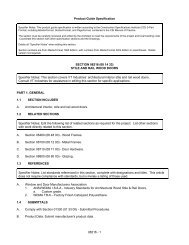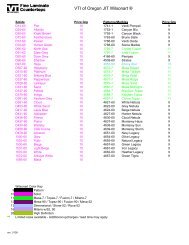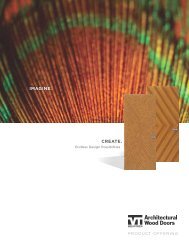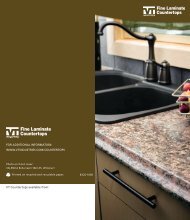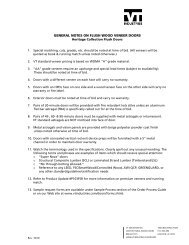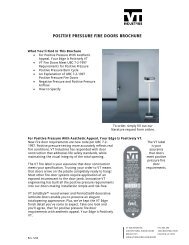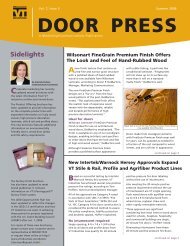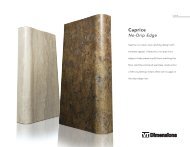architectural wood doors - VTonline
architectural wood doors - VTonline
architectural wood doors - VTonline
Create successful ePaper yourself
Turn your PDF publications into a flip-book with our unique Google optimized e-Paper software.
ARCHITECTURAL WOODDOORSV ENEER GUIDEL I NES
PLAIN SLICED MAPLE VeneerSMAPLENATUrAL VARIATIONSThe word natural brings to mind certain connotations like“beauty”, “warmth” and “purity”. Merriam-Webster defines naturalas “occurring in conformity with the ordinary course of nature(the genetically controlled qualities of an organism): not marvelousor supernatural”.Wood is a product of nature, and in some cases, will accentuateand enhance a project design when used in its purest, or natural,state. However, as a product of nature, each <strong>wood</strong> species hascertain intrinsic and industry-acceptable characteristics, which canvary from tree to tree and flitch (half log) to flitch. It is preciselythese naturally occurring variations that provide such richness anduniqueness to each project design.Certain <strong>wood</strong> species such as natural maple, birch and ash can varywidely in color range, which is why in many cases select white isspecified so that the sap<strong>wood</strong> can be accumulated and splicedtogether to create a consistent color. The photos and information inthis brochure are designed to assist you in specifying and receivingthe product you envision.Plain Sliced Natural Maple
HOW TO SPECIFY:Grade A natural veneers, such as maple, birch andash, may contain sap<strong>wood</strong>/heart<strong>wood</strong> combinations,color streaks, spots and color variation from almostwhite to very dark, according to WDMA I.S. 1-A andAWI quality standards. No backcharges will beaccepted for allowable characteristics in naturalveneers. To avoid these noticeable color and grainvariations, select white veneers must be specified.Plain Sliced Select White Maplep l a i n s l i c e d m a p l e C h a r a c t e r i s t i c sSpecies Type & Cut Grade Sap<strong>wood</strong> Heart<strong>wood</strong> Color Color Mineral Small Burls or CrossStreaks or Variation Streaks Pin Knots BarsSpotsMaple PI-SI Natural A Y Y Y Y S 1 per 3 sq. ft. SPI-SI White A Y N S S S 1 per 3 sq. ft. SPI-SI Red* A N Y Y Y S 1 per 3 sq. ft. SY = Yes N = No S = Slight*Maple heart<strong>wood</strong> is so low in content that it is rarely available in sufficient quantities for commercial use.Chart information referenced from WDMA I.S. 1-A.
PLAIN SLICED BIRCH VeneerSBIRCHPlain Sliced Natural Birchp l a i n s l i c e d B I R C H C h a r a c t e r i s t i c sSpecies Type & Cut Grade Sap<strong>wood</strong> Heart<strong>wood</strong> Color Color Mineral Small Burls or CrossStreaks or Variation Streaks Pin Knots BarsSpotsBirch PI-SI Natural A Y Y Y Y S 1 per 3 sq. ft. SPI-SI White A Y N S S S 1 per 3 sq. ft. SPI-SI Red A N Y Y Y S 1 per 3 sq. ft. SY = Yes N = No S = SlightChart information referenced from WDMA I.S. 1-A.
HOW TO SPECIFY:Grade A natural veneers, such as maple, birch andash, may contain sap<strong>wood</strong>/heart<strong>wood</strong> combinations,color streaks, spots and color variation from almostwhite to very dark, according to WDMA I.S. 1-Aand AWI quality standards. No backcharges will beaccepted for allowable characteristics in naturalveneers. To avoid these noticeable color and grainvariations, select white veneers must be specified.Plain Sliced Select White BirchPlain Sliced Birchp l a i n s l i c e d B I R C H C h a r a c t e r i s t i c sSpecies Type & Cut Grade Sap<strong>wood</strong> Heart<strong>wood</strong> Color Color Mineral Small Burls or CrossStreaks or Variation Streaks Pin Knots BarsSpotsBirch PI-SI Natural A Y Y Y Y S 1 per 3 sq. ft. SPI-SI White A Y N S S S 1 per 3 sq. ft. SPI-SI Red A N Y Y Y S 1 per 3 sq. ft. SY = Yes N = No S = SlightChart information referenced from WDMA I.S. 1-A.
Wood color variationsVARIAT<strong>wood</strong> color Variationsamong same speciesAlthough maple, birch and ash show the greatest contrasts incolor and grain, all <strong>wood</strong> species can vary from flitch to flitch.Environmental factors such as climate and soil content can makeeach veneer species exhibit a range of colors and textures.TMPERMAGUARD FACTORYFINISH SAMPLESAll Permaguard factory finish samples illustrate basic color, grainfill and gloss level of our catalyzed polyurethane finish system.Wood is a product of nature and will vary in color and grainfrom tree to tree, or even within the same tree. Some <strong>doors</strong> willbe lighter or darker even though they all receive the same colorstain, but it’s precisely those natural variations in density andtexture that make <strong>wood</strong> <strong>doors</strong> so popular. For more informationon our VT Color Choices, please refer to our Permaguard FactoryFinish brochure.All samples submitted for approval use A grade book and runningmatch veneers, unless otherwise specified.Plain Sliced Cherry
IONSrange of colors on same specieswith different flitchesPhotos below show range of <strong>wood</strong> color variation using different flitches of same species. Veneers have clear finish – nostains were added to samples.CherryRed OakWhite Maple
premium gradeVENEERSwhat is a premium grade veneer?VT Industries has always maintained the highest quality standards as set forth by the <strong>architectural</strong> flush <strong>wood</strong> doorindustry – meeting or exceeding industry quality standards. The primary quality standards are 1) the Window & DoorManufacturers Association (WDMA) I.S. 1-A; 2) the American Woodwork Institute (AWI) Quality Standards, sections1300 and 1500; and 3) the Woodwork Institute Manual of Millwork. AWI and Woodwork Institute quality standardsare very similar, having changed their standards for premium grade <strong>doors</strong> in recent years, which has caused somediscrepancies with WDMA, the benchmark by which most flush door manufacturers set their standards.AWI and the Woodwork Institute require AA grade veneers based onHPVA panel veneer grading tables – book, slip or random match – centerbalance matched between veneer components for use on theirpremium grade <strong>doors</strong>. Nominal minimum width of face components for premiumgrade veneers is 6" for plain sliced veneer, 3" for quarter sliced veneers, and6" for rotary cut veneers. AWI defines premium grade veneers as, “The gradespecified when the highest degree of control over the quality of workmanship,materials, installation and execution of the design intent is required. Usuallyreserved for special projects, or feature areas within a project.”WDMA's standard for premium grade <strong>doors</strong> requires A grade veneers (as opposedto the optional AA grade) based on HPVA door veneer grading tables – book, slipor random-running, balance or center balance match between veneer components.Nominal minimum width of face components for premium grade veneers is 4" forplain sliced veneers, 3" for quarter sliced veneers and 4" for rotary cut veneers.Minimum width for AA grade is 5" for plain sliced veneers, 3" for quarter slicedveneers and 5" for rotary cut veneers.The use of AA grade veneers is not only more costly, it can dramatically increaselead times and wastes large amounts of veneer to accumulate the componentsrequired to meet the AA grade requirements. VT will provide AA grade veneerswhen specified, but encourages the use of A grade veneers for environmentalresponsibility. VT also uses water-based stains and solvent-free sealers, whichare much safer for the environment and the individuals who work with them.Our catalyzed polyurethane factory finish is UV-cured to eliminate harmful volatileorganic compound (VOC) emissions.Plain Sliced Red Oak
decorative veneer cuttingMETHODSHalf LogFlitchKnifeCathedralpatternPLAIN SLICED OR FLAT CUT VENEER:LeafBlockPLAIN SLICED OR FLAT CUT (SLICER):Leaf width depends on log size andplacement in flitch. Half Round is asomewhat similar pattern achieved byturning a half log flitch on a lathe.The half log, or flitch, is mounted with the heart side against the guide plateof the slicer. Cuts are made parallel to a line through the center of the log,producing a distinct figure. By keeping the veneer leaves in the same orderin which they are cut, the leaves can be reassembled with only a very gradualgrain figure transition from one panel to another.Quarter Log FlitchKnifeQUARTER SLICED (SLICER):NarrowstripedpatternFlake pattern is produced when slicingthrough medullary rays in some species,principally oak.QUARTER SLICED VENEER:A quarter log, or flitch, is mounted so that the slicer cuts the log at a 45angle to the axis lines of the log, creating a striped or straight grain effect.A flake effect is produced in oak veneers using this method.oQuarter LogFlitchKnifeRIFT CUT (LATHE):NarrowstripedpatternAngle of cut is 15 degrees to the radialto minimize the ray (flake effect) in oak.Comb grain is the portion which hasVERY tight and straight grain.RIFT CUT VENEER:This method is generally restricted to Red and White Oak. A quarter log ismounted off center and cut slightly across the medullary rays common to oak,resulting in a straight grain without the flake effect of quarter sliced oak.KnifeROTARY (LATHE):Very broadpattern,often wildWide Sheets. Broad pattern. Difficultmatching. Used primarily on Economyor Commercial grades.ROTARY CUT VENEER:A method of cutting in which the log is placed on a large lathe and turnedagainst a fixed blade, so that a continuous cut is made round and round thelog, more or less parallel at all times to the growth ring. The result is a wild,varied grain effect. Since the grain pattern is non-repetitive, it cannot be usedfor sequence matching.
MATCHING and assembly of VENEERCOMPONtypes of matchOnce the decorative veneer cutting method is specified, the typeof match at the joint line must be specified. The way in which theindividual cuts are placed next to each other during the fabricationof the veneer face affects the appearance of the <strong>doors</strong>.Book Match - Book Match is the most commonly used matchin the industry. Every other piece of veneer is turned over soadjacent pieces are opened like two adjacent pages in a book.The veneer joints match and create a mirrored image patternat the joint line, yielding a maximum continuity of grain. Bookmatching is used with plain sliced, and less often with othercuts of veneer.Barber pole effect in book match - Because the “tight” and“loose” faces alternate in adjacent pieces of veneer, they mayaccept stain or reflect light differently, resulting in a noticeablecolor variation, often called “barber pole”. These variations arenot considered a manufacturing defect.Slip Match - Slip Match is the adjoining of veneer componentsin sequence without turning over every other piece. The grainfigure repeats, but joints won’t show a mirrored effect. Slipmatching is often used in quarter cut, rift cut and comb grainveneers to minimize the barber pole effect.Random Match - A random selection of veneer componentsfrom one or more logs. This produces a “board-like” appearance.Book MatchSlip MatchRandom Match
NENTStypes of assembly matchThe type of “assembly match“ must be specified to obtain a desiredappearance. Any sequence matching from opening to opening mustbe specified.RemaindersRunning Match - Non-symmetrical appearance on any singledoor face. Veneer pieces of unequal width are common. Eachface is assembled from as many veneer pieces as necessary.Balance Match - Symmetrical appearance. Each face is assembledfrom an even or odd number of pieces of uniform width beforetrimming. This match reduces veneer yield.Center Balance Match - Symmetrical appearance. Each face isassembled from an even number of veneer pieces of uniformwidth before trimming. Thus, there is a veneer joint in thecenter of the panel. This match further reduces veneer yield.Book Match - Running MatchBalance MatchReprinted from AWI Quality Standards.Center Balance Match
OUR COMMITMENT TO THE ENVIRONMENTWith VT flush <strong>wood</strong> and stile & rail <strong>doors</strong>, you don't have to sacrifice beauty to protect the environment. VT Doors are manufacturedin a highly efficient, environmentally friendly facility. VT Industries <strong>architectural</strong> <strong>wood</strong> <strong>doors</strong> are the only GREENGUARD Certified ®<strong>wood</strong> <strong>doors</strong> available. They are also available with FSC certified materials and are listed on GreenSpec ® .1000 INDUSTRIAL PARKP.O. BOX 490HOLSTEIN, IA 51025P 800.827.1615 EXT. 564F 712.368.4163DOOR_INFO@VTINDUSTRIES.COMWWW.VTINDUSTRIES.COM/DOORSDoors featured on cover (left to right): Quarter SlicedFigured Makore, Clear Finish; Plain Sliced Red Oak,Clear Finish; Plain Sliced Cherry, Clear FinishPrinted on recycled and recyclable paper.BJVG-0208




